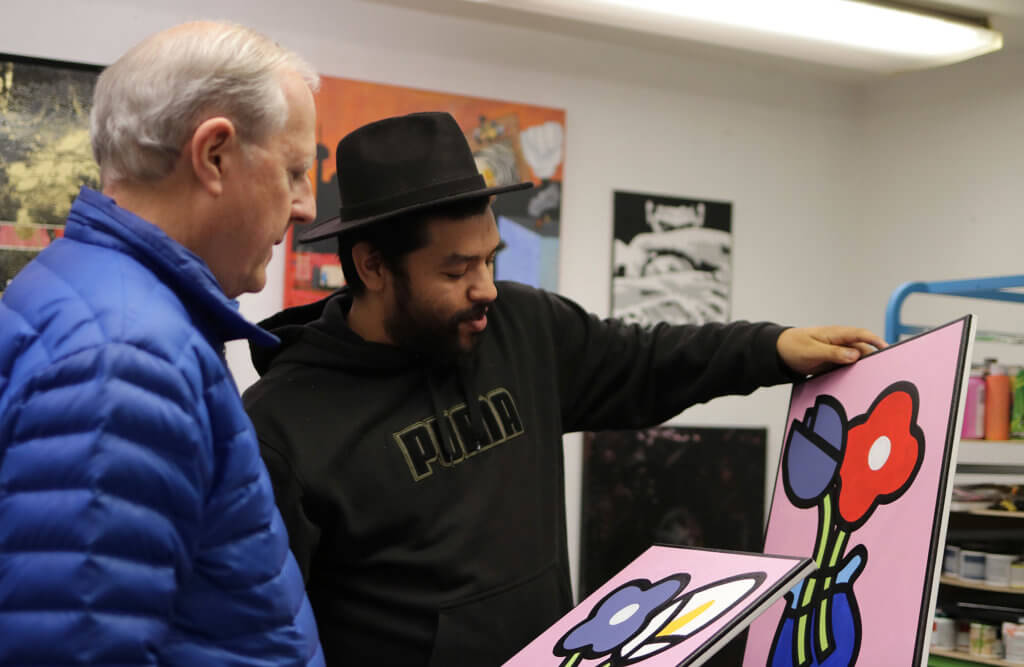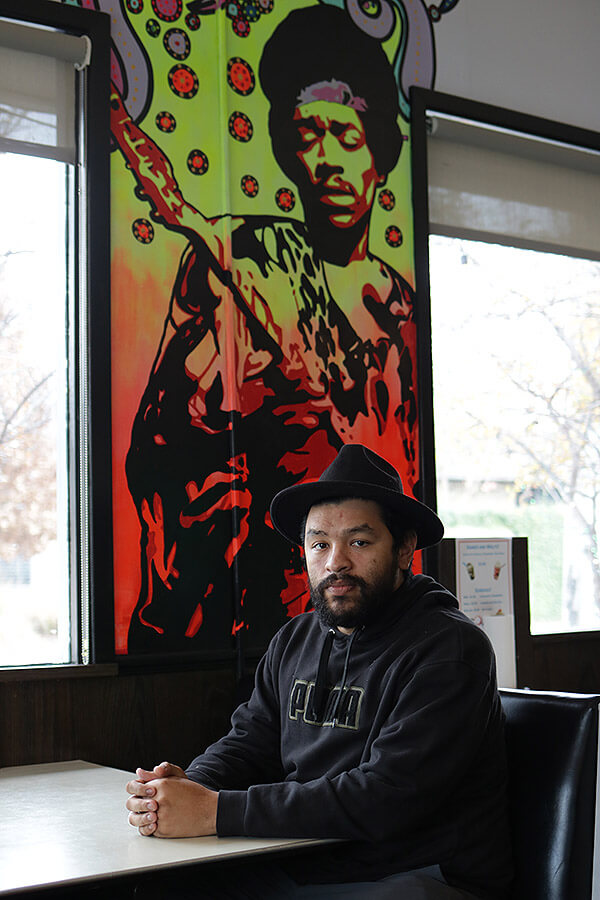Lanier High School graduate Albert Gonzales wants to inspire young people with his art and his story of turmoil.
When artist Albert Gonzales wasn’t falling asleep on park benches, he’d take the last bus to the IHOP — either to the one on Broadway or by Loop 410. He’d purchase a coffee, sit in the corner booth next to the area where the employees rolled silverware, and draw all night.
In 2015, this was Gonzales’ routine.
“It was sad, but those people were my friends,” Gonzales said about his times at IHOP. “They wanted to help me and they could’ve told me, ‘Hey man, you gotta leave, you can’t be sleeping there. They understood what I was trying to do, and if I dozed off for a couple hours, they would let me sleep there.”
Gonzales, now 27, recalls his trying moments easily, because they weren’t that long ago.
These days, the artist’s work can be found on public walls and private homes, from the University of Texas at San Antonio to the residence of Spurs legend Tim Duncan.
Today, Gonzales uses his platform to inspire other artists and youth in lower-income areas. The 2009 Lanier High School graduate has been involved in several charitable campaigns. He’s raised $8,000 for the Susan G. Komen Foundation. He’s crafted banners with Fox Tech students and has shared his story with students of Lanier and Healy-Murphy high schools.
“I radiate positive energy to other people and use my story to help others out,” Gonzales said. “If I do it for someone, then they’ll want to help someone else out, and it becomes a positive cycle.
“I remember speaking to 300 Lanier kids, and I asked them, ‘How many of ya’ll have been to an art exhibit or museum?’ And only three of them raised their hands.”
Gonzales hopes that positive energy can help inspire young children from distressed areas to do more in life. The doors to his studio are open for everyone to be mentored — or for folks who just want to get out of the barrio.

Albert Gonzales shows art patron Gene Marck one of his Wabi Sabi paintings in his studio at Hausmann Millworks on West Russell Place. Jose Arredondo | Folo Media
Doodling days
Gonzales’ early memories of art date back to elementary school when he’d draw Bugs Bunny. He would press a sheet of paper against the lunch box and trace the Looney Tunes characters. He challenged himself by drawing the characters without tracing them, and admitted that parts of the characters looked clean and others not so much.
“That was my first recollection of experimenting with different art techniques,” Gonzales said, smiling. “I kept doodling and stuff like that, from elementary through high school, but it was never something serious.”
When Gonzales graduated from Lanier in 2009, he found himself working multiple jobs he didn’t like, most recently at CVS Pharmacy in 2014. Despite the 9-to-5 hours, he couldn’t survive on the pay, which led him to move in with his mother.
He caught himself drawing at work, home, and when hanging out with his friends. People often praised his gift to craft art, but his response was always, “I’m not an artist.”
Then one night before going to his job at CVS Pharmacy, he had a dream.
“I had my clothes sorted out the night before work and asked myself, ‘Do I really want to do this every day, for nine hours a day, for the rest of my life?’” Gonzales recalled.
He woke up, hopped on his bike and peddled to work because he was late. While at work, Gonzales doodled, and his manager jokingly told him to stop or he’d receive a write-up. He stood up from his desk and quit his job.
“It was probably one the dumbest decisions I’ve ever made, but also the most rewarding,” Gonzales said, sitting in his studio.
Solo journey
Gonzales’ family and peers didn’t take his leap from desk job to full-time artist seriously. His mother didn’t view art as a realistic goal and advised that he get “a real job.” He moved out of her home with $300 to his name.
With that money, he purchased art supplies and large bags to store them in. He carried a garment bag and his portfolio, and pulled a wheeled, airport duffle bag, around town. He created art for $1, $5 and $20.
His studio? IHOP, plus the spaces where he performed live art.
While homeless, Gonzales slowly established himself as a common face in the art scene. Robert Gaytan, a childhood friend, ran into Gonzales on the street and heard about his situation. Gaytan offered his home to Gonzales for $25 a month.

Gonzales sits in front of his portrait of Jimi Hendrix at the Burger Culture restaurant south of downtown. Jose Arredondo | Folo Media
“He actually believed in me, which took a huge load off of my shoulders because I finally had a roof over my head,” Gonzales said. “All I did was paint. If I wasn’t painting in the streets, I was painting at his house.”
When Gonzales displayed his art at First Friday in 2015, he felt discouraged. People blindly walked by his setup, in front of Madhatters. He sat on the curb with $5 in his pocket. He questioned his abilities: “Does my art suck? Why doesn’t anyone pay attention to art? I’m pouring my heart out.”
When Gonzales cried, a woman stopped to pray over him.
“That was a sign from God, that everything was going to be OK,” Gonzales said.
Hours later, a man purchased an abstract piece titled “Walk the line” for $150.
Gonzales painted 60 pieces of art in the span of three months. He saved up money and used it to launch a weekend solo exhibition in October 2015. That exhibition opened with a performance where Gonzales sat in a barber chair surrounded by his art as 40 people watched.
“When you sit with your barber, you usually talk to them and catch up on life,” Gonzales said. “I was telling the barber about my struggles and everything that led up to that day on the chair. I cried, and my mom cried.”
Gonzales felt the performance was a success despite only selling three paintings. But the night did not end there.
At one point during the show, a collector, Christopher Poulas, pointed out paintings he liked, and left. Two weeks later, Poulas called Gonzales to discuss the art that caught his interest.
“I brought him the five paintings and he asked me, ‘Can we make a deal?’” Gonzales said, as tears formed. “I never thought in my first year of being an artist that I would sell a piece for $800. I sold them to him for $1,500.”
By December, Gonzales only had four paintings left.
He invested the money into an art space in January 2016 at Hausmann Millworks, a facility composed of galleries and office spaces near Fredericksburg Road. He split the studio space with another local artist so it could be affordable.
A month later, On and Off Fredericksburg Road Studio Tours, a weekend long event created to promote artists, hosted dozens of collectors.
During On and Off Fred, a weekend-long tour of galleries on and off Fredericksburg Road, former UTSA president Ricardo Romo walked into Gonzales’ studio and introduced himself. Romo heard about Gonzales through artist Rex Hausmann, which made Gonzales even more nervous.
Then Romo pointed to one of his paintings — “I want that one” — then to another — “that one” — then another, and another.
“I remember telling myself, ‘That’s $5,000 worth of art,’” Gonzales recalled, “and he told me he wanted them inside UTSA.”
This year, Gonzales and Romo, an artist himself, will collaborate on a San Antonio Tricentennial project that will include a pop-up art exhibit. He said the exhibit will hit every ZIP code in San Antonio, and he hopes it brings people together.
Recently, Gonzales sat at his studio painting a Wabi Sabi piece. His table was full of supplies. He often plays YouTube videos while he crafts pieces, but on this day, he was listening to Eddie Murphy’s “Delirious” stand-up special. The jokes stopped when his phone rang.
“Hello?” Gonzales asked. “Oh, you are here. Alright, I’ll be there.”
Gonzales opened the door to his studio and Gene Marck, 71, walked in. Marck is one of Gonzales’ regular customers. The two met at Lone Star Studios art gallery and have been friends since.
“We (Marck and his girlfriend) were very attracted by the look, the colors and the simplicity of his work,” Marck said of Gonzales’ art. “We started purchasing and we got our friends to look at it. We use his art as gifts to relatives and friends all over the country.”
Last year, Marck hosted a Harvard Business Alumni Christmas party at the Cellars At Pearl, a 10-story luxury apartment complex. Gonzales and his fiance, Caroline Adam, were the guests of honor and their art was displayed in the party room.
“I would have never imagined that I would be at these places with important people,” Gonzales said, smiling. “I love telling my story because that gives others hope that if they work as hard as me, if not harder, they can accomplish anything unimaginable.”
Less than two miles away from the Cellars, just a few years earlier, Gonzales was homeless, and drawing in the corner booth at IHOP.
This article was originally published by the H.E. Butt Foundation’s Folo Media initiative in 2017.